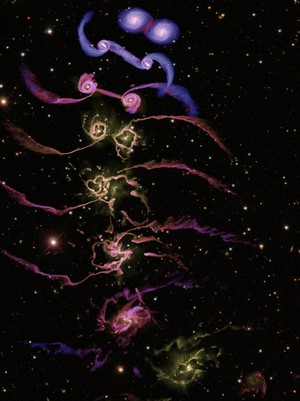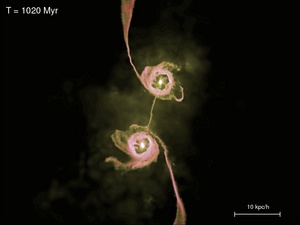 |
|
Different phases of the merger of two galaxies with central
supermassive black holes. From top to bottom, the individual images
of the sequence show the gas of two colliding spiral galaxies. After
the first encounter, they first separate again from each other, but
then come together for a second encounter and subsequent
coalescence. Gravity is driving gas into the centers of the galaxies
and leads to the formation of extended tidal arms. As a result of the
nuclear inflow, the black holes grow strongly in mass during a quasar
phase. This phase lasts up to 100 million years and releases enough
energy to heat the gas and to expel it into extragalactic space. At
the end an elliptical galaxy remains (its stars are not shown in the
image sequence) which contains almost no residual gas and hosts at its
center the merged pair of supermassive black holes.
|
 |
 |
|
Please click on the picture to start the movie.
Time evolution of a galaxy merger over a period of 2 billion years.
Only the gas distribution is shown, where brightness increases with
gas density while the color hue encodes the gas temperature, from
blue/cold to yellow/hot. The movie has high resolution (20 MB,
1024x768 pixels) and may require the divx/MPEG-4 codec for playback;
it can be downloaded for free for Windows, Apple, and Linux platforms
at http://www.divx.com, if needed.
|
|  |
Collisions and mergers of galaxies play an important role in the
modern picture of galaxy formation. Over time, they lead to the build
up of ever larger galaxies with modified morphology. For example,
merging spiral galaxies are transformed into elliptical
galaxies. However, the recent discovery of supermassive black holes at
the centres of most galaxies poses new puzzles for astronomers. It is
unclear why the mass of black holes is so well correlated with the
size of the stellar bulge of galaxies. Are black holes only an
interesting side phaenomenon of the formation of galaxies, or are they
possibly influencing the process in a decisive way?
Answers to these questions can be provided by complex computer
simulations which account for the gravitational dynamics of
individual galaxies as well as for the most important aspects of the
physics of star formation and the growth of black holes. Tiziana Di
Matteo and Volker Springel from the Max-Planck Institute for
Astrophysics, and Lars Hernquist from Harvard University, have devised
new ways to study this problem numerically: They represented the
supermassive black hole with a simulation particle which can accrete
gas from its surroundings, with a rate estimated based on a simple
theoretical model. In this way, they could simulate whole galaxies
together with the growing black holes embedded at their centres.
Due to fricting in the gas flow around the black holes, the infalling
gas is heated to enormous temperatures and emits energetic
radiation. In fact, about 10 per cent of the total rest mass enery (E
= mc2) of the gas is released before it vanishes in the event horizon
of the black hole. These are huge amounts of energy, turning the black
holes into real monsters, the strongest known sources of energy in the
Universe. While most of the energy escapes from the center of the
galaxy, a small part of it heats the gas in the larger environment of
the black hole. The team around Dr. Di Matteo assumed that about 5 per
cent of the radiation contributes to this heating.
The simulations have now shown that this energy has a crucial
influence on mergers of spiral galaxies. When the galaxies collide,
gravitational tidal forces drive diffuse gas into their centers. There
it is compressed until an intense burst of star formation is
triggered. At the same time, the infalling gas is also feeding a
nuclear supermassive black hole which therefore quickly grows in
mass. The energy released by this growth is strongly heating the
surrounding gas. Figure 1 shows the distribution and temperature of
the gas in different phases of the merger of two galaxies of size
comparable to the Milky Way. The more massive the black hole becomes
the faster it grows further, so that the rate of energy release
quickly becomes larger. The center of the galaxy is shining as a
luminous quasar in this phase. However, eventually the pressure in the
heated gas becomes too large - a powerful wind is formed which expels
the remaining gas in the galaxy out of the center, thereby terminating
the quasar-phase and the starburst on a short timescale.
Tiziana Di Matteo, Volker Springel and Lars Hernquist have studied a
series of simulations with collisions of galaxies of different
size. They show that in larger galaxies more gas is available to feed
a black hole and that the gravitational potential that binds this gas
is deeper, so that the black holes have to grow to ever larger masses
before their released energy is sufficient to stop the quasar activity
by expelling the gas. The growth is therefore a self-limiting process
which is at the same time linked to the formation of the stellar bulge
in the center of galaxies: A direct connection between the size of
this stellar population and the mass of the black hole in the merger
remnant is established. A comparison with astronomical data shows that
these first self-consistent simulations for the growth of black holes
are already in remarkable agreement with the most important
observational data.
These results have far reaching implications for the standard model
of hierarchical galaxy formation: The acitivity of a black hole has
large effects on its host galaxy because it can reduce the strength of
the starburst during a merger of galaxies and also limits later star
formation due to the heating of the gas. As a result, the formed
elliptical galaxies are comparatively gas poor and show little
residual star formation; their stellar populations are therefore aging
quickly and develop those red spectral colors that are observed in
many massive elliptical galaxies today. Without the influence of the
black holes, the colors of these "dead" elliptical galaxies are
difficult to understand.
Galaxy formation and the growth of supermassive black holes appear as
a tightly linked process which should be treated as a unity in future
theoretical models. Hydrodynamical numerical simulations are among of
the most promising tools to gain further insights into this
fascinating conncetion.
Tiziana Di Matteo, Volker Springel, Lars Hernquist
Original publication:
Tiziana Di Matteo, Volker Springel, Lars Hernquist:
Energy input from quasars regulates the growth and activity of black
holes and their host galaxies,
Nature, 10 February 2005
|